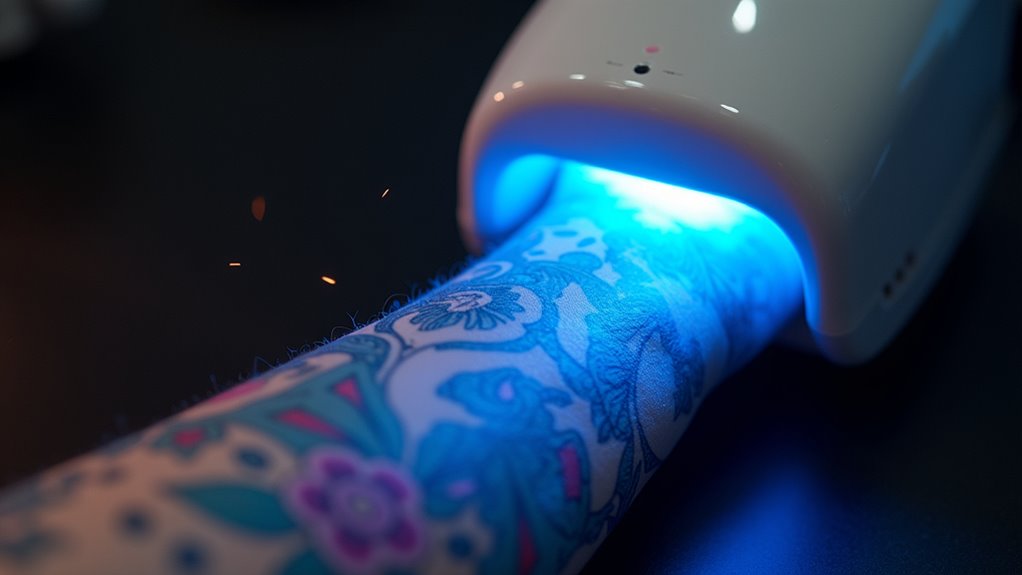IPL on tattooed skin is risky because pigments in ink can absorb light, leading to fading, discoloration, or skin damage. Different ink colors respond differently, with some more vulnerable to alteration or burns. Without professional guidance, you risk uneven results, scarring, or long-term damage. To make safe choices and protect your skin and tattoo, it’s important to understand the risks and explore better options—more details will help guide you.
Key Takeaways
- IPL targets pigments in skin and ink, risking fading, discoloration, or uneven pigmentation in tattooed areas.
- Ink composition and color influence sensitivity to IPL, with lighter inks more prone to damage.
- Improper IPL settings can cause burns, hyperpigmentation, scarring, or long-term skin damage over tattoos.
- Patch testing and professional assessment are essential to minimize risks when treating tattooed skin with IPL.
- Alternative skin rejuvenation methods may be safer options for tattooed areas, reducing the risk of tattoo damage.
Understanding How IPL Works on the Skin

Intense Pulsed Light (IPL) therapy works by emitting broad-spectrum light that targets specific skin structures. When you undergo IPL, the light energy is absorbed by pigments and blood vessels, helping treat various skin concerns. However, due to its broad-spectrum nature, IPL can also affect skin pigmentation, especially in tattooed areas, where ink absorbs the light differently. This makes laser safety a critical consideration, as improper settings can cause burns, hyperpigmentation, or hypopigmentation. The pigment in your skin influences how the light is absorbed and how your skin reacts during treatment. If you have tattoo ink, it can alter the light’s effectiveness and safety profile. **Proper filtration and understanding laser safety protocols** are essential for minimizing risks during IPL treatments. Understanding how IPL interacts with skin pigmentation helps minimize risks and ensures safer, more effective treatments.
The Nature of Tattoo Ink and Its Placement in the Skin
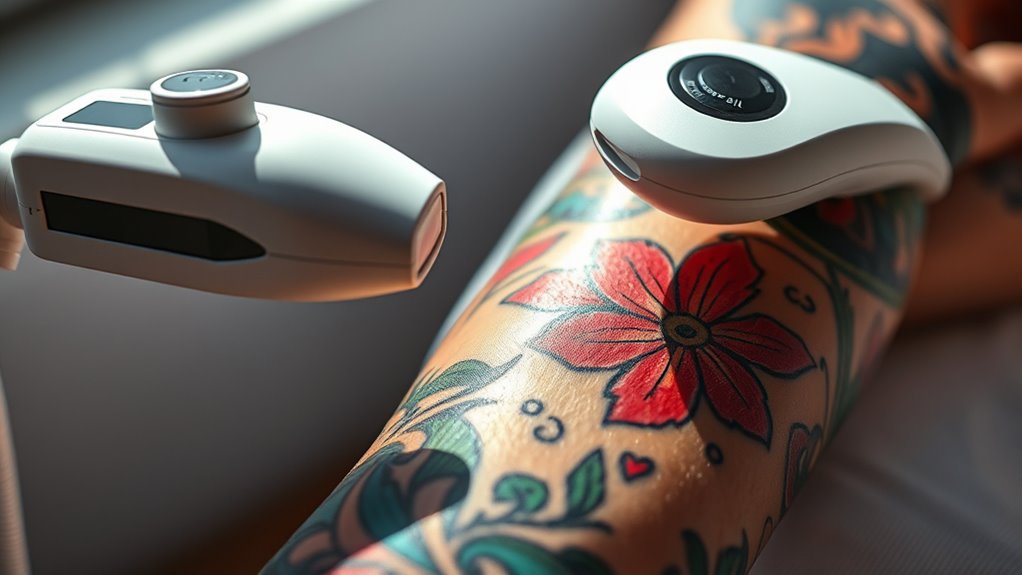
Tattoo ink consists of tiny pigment particles deliberately deposited into the skin’s dermis layer during the tattooing process. The composition of tattoo ink varies, typically including pigments, carriers, and preservatives. These pigments can be organic or inorganic, influencing how the ink interacts with your skin. Because the ink resides in the dermis, where your immune system struggles to remove it, the tattoo remains permanent. Tattoo placement sensitivity differs across body areas; some regions have thinner skin or more nerve endings, affecting your experience. Additionally, certain ink components may cause allergic reactions or other skin sensitivities, emphasizing the importance of understanding tattoo ink composition.
Potential Effects of IPL on Tattooed Skin
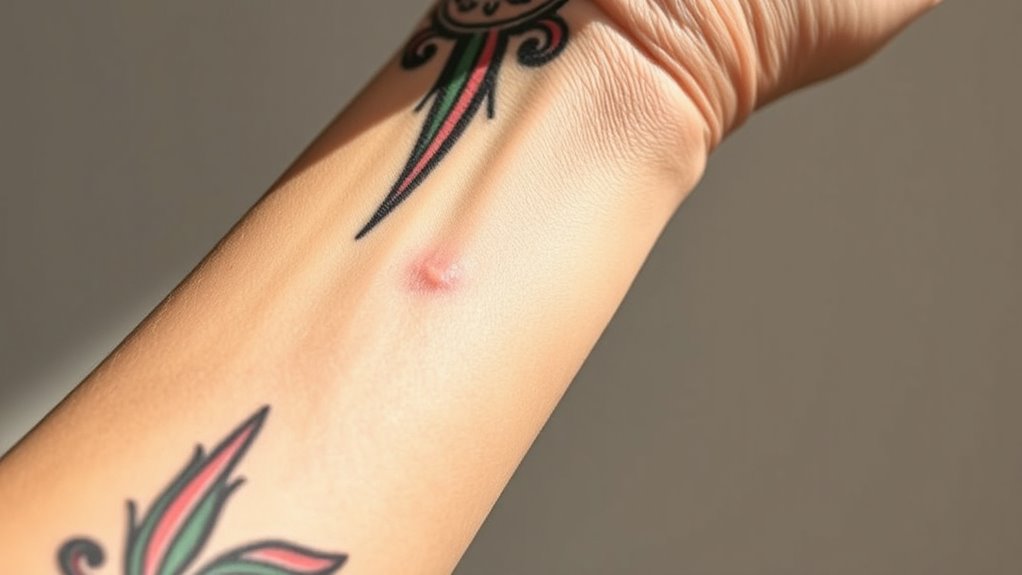
When you undergo intense pulsed light (IPL) treatments on tattooed skin, the energy from the device can affect both your skin and the embedded ink. The effects depend on tattoo ink composition and IPL wavelength specificity. Certain ink pigments are more sensitive to specific wavelengths, making them more prone to damage. IPL targets chromophores in the skin, but tattoo inks can absorb this energy, risking pigment alteration or degradation. This can lead to unpredictable changes in color or texture, especially with inks containing metallic or complex pigments. The wavelength used determines how deeply the light penetrates and which ink components are affected. As a result, IPL treatments may cause fading, discoloration, or uneven pigmentation in tattooed areas, highlighting the importance of understanding these potential effects before proceeding. Additionally, skin sensitivity can vary based on individual factors and the presence of tattoos, further influencing the outcome.
Risks of Fading and Discoloration With IPL Treatments

You should be aware that IPL treatments can cause fading or discoloration in tattooed skin, especially if your ink contains sensitive colors. Certain ink shades may react differently, leading to uneven fading or patchy areas. This can also result in irregular skin tone around the tattoo, affecting your overall appearance. Additionally, understanding the potential for skin irritation can help you better prepare for treatment and discuss concerns with your specialist.
Ink Color Sensitivity
Ink color plays a crucial role in how your tattoo responds to IPL treatments, as certain hues are more prone to fading or discoloration. Your tattoo ink’s color influences its ink color sensitivity, affecting the risk of damage during laser sessions. Darker inks like black and deep blue generally absorb IPL energy better, making them less susceptible to fading. Conversely, lighter shades such as yellow, green, and pastel colors tend to be more vulnerable, increasing the chance of discoloration or fading. Additionally, the subtopic 2: Internal Company Hackathons focus on encouraging innovation and creative problem-solving, which can be analogous to understanding how different ink colors respond to laser treatments.
Uneven Skin Tone
Uneven skin tone can considerably increase the risk of fading and discoloration during IPL treatments. If your skin has areas of skin unevenness, the laser may target some spots more intensely than others, leading to inconsistent results. This unevenness can cause tattoo fading in unwanted areas or create patches of discoloration. When skin tone isn’t uniform, IPL might intensify these issues, making your tattoo look patchy or faded unevenly. Additionally, understanding the importance of vibrational alignment can help you maintain a positive outlook and select appropriate skin treatments. If you have existing skin unevenness, it’s crucial to consult with a specialist before opting for IPL. They can assess whether your skin’s condition could heighten the risks of fading or discoloration, ensuring you understand the potential outcomes and avoid unwanted changes to your tattoo or skin appearance.
Skin Damage and Scarring Concerns for Tattooed Areas

Laser treatments like IPL can pose risks to tattooed skin, primarily because the pigment absorbs the light energy, which can lead to skin damage or scarring. If you’re considering tattoo removal with IPL, you should be aware that the pigment in your tattoo absorbs the laser, increasing the chance of burns or permanent scars. Tattooed skin often has heightened skin sensitivity, making it more vulnerable to damage from intense light exposure. Even if you’re not seeking removal, IPL might cause adverse effects such as blistering, hyperpigmentation, or scarring over tattooed areas. This is especially true if your skin is prone to irritation or if the tattoo is recent. Protecting tattooed skin during IPL treatments is essential to avoid long-term damage.
Factors Influencing the Interaction Between IPL and Tattoos

Several factors determine how IPL interacts with tattooed skin, influencing the risk of complications such as burns, hyperpigmentation, or scarring. First, the ink composition matters: certain pigments absorb IPL more intensely, increasing risk. Second, tattoo age plays a role—older tattoos tend to have faded ink, reducing IPL absorption. Third, the location and depth of ink affect how IPL energy interacts, with deeper or densely pigmented tattoos posing higher risks. Additionally, your skin type influences heat dissipation, impacting potential damage. When considering tattoo removal or IPL treatments on inked skin, understanding these factors helps minimize adverse effects. Always evaluate ink composition and tattoo characteristics before proceeding, and consult a professional to assess your specific situation. Moreover, being aware of current news and advances in dermatological treatments can inform safer choices.
Recommendations for Those Considering IPL on Tattooed Skin
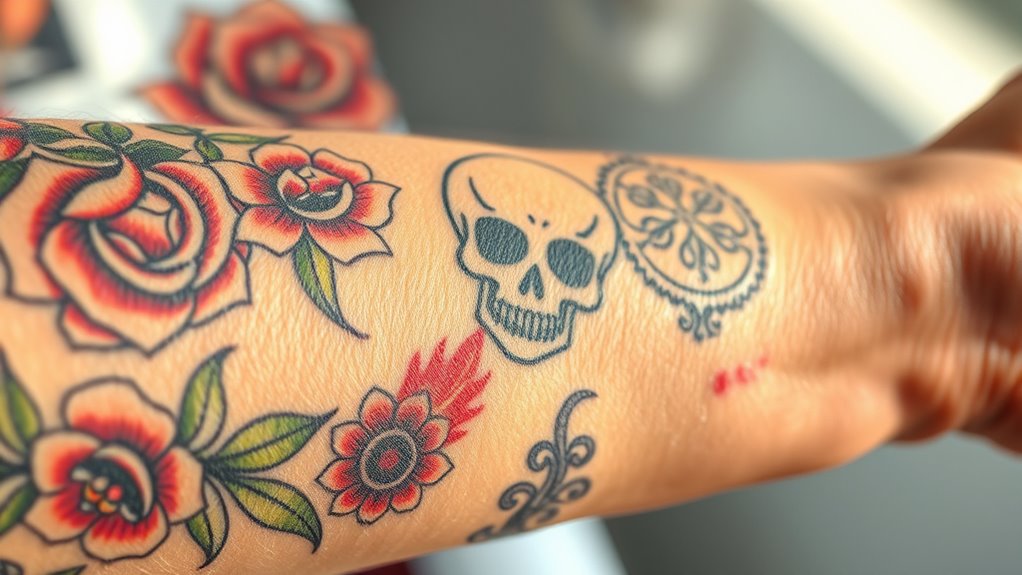
Before you get IPL on tattooed skin, it’s vital to consult a specialist to evaluate potential risks. They can advise if your tattoo and skin type are suitable for treatment. Additionally, a patch test is recommended to check for any adverse reactions before proceeding.
Consult a Specialist First
If you’re considering IPL treatment on tattooed skin, consulting a specialist beforehand is essential. A professional can assess the risks and guarantee proper laser safety measures, reducing the chance of adverse effects. They’ll evaluate your tattoo’s ink type, colors, and placement to determine if IPL is suitable. Additionally, understanding the potential risks associated with laser treatments on tattooed skin can help you make a more informed decision. Before proceeding, ask your specialist: 1. If IPL might cause pigment changes or damage to your tattooed skin. 2. About alternative treatments, like tattoo removal, that might be safer. 3. How they plan to minimize risks and protect your skin during the procedure. A knowledgeable expert will guide you on whether IPL is a good option for your skin and tattoo. Prior consultation helps you make an informed choice and avoid unwanted complications.
Patch Test Recommended
Since tattooed skin reacts differently to IPL treatments, a patch test is highly recommended before your full procedure. The composition of tattoo ink, including its pigments and chemicals, influences how your skin responds to IPL technology basics. Some inks, especially those with metallic or synthetic components, can absorb laser energy differently, increasing the risk of adverse reactions. A patch test allows you to see how your skin reacts to IPL on a small area, helping to identify potential risks like blistering or color changes. This step is vital because tattoo ink composition varies widely, and IPL technology can interact unpredictably with certain pigments. Additionally, understanding the effects of pigment composition can help in assessing the safety of IPL treatments on tattooed skin. Always perform a patch test under professional supervision to guarantee safety and determine whether IPL is a suitable option for your tattooed skin.
Alternatives to IPL for Skin Rejuvenation in Tattooed Areas
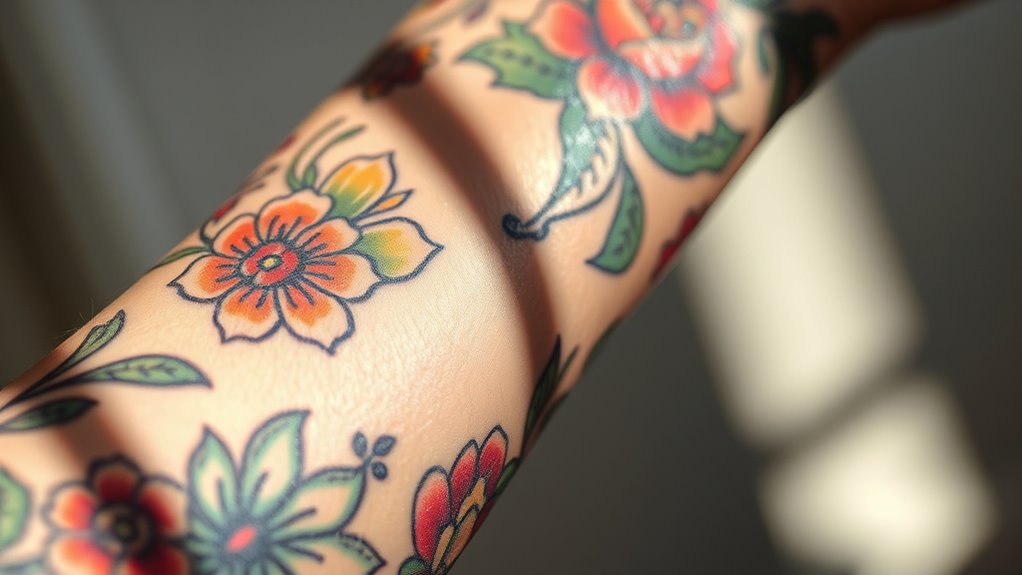
When considering skin rejuvenation in tattooed areas, traditional IPL treatments may not be suitable because the tattoo ink can absorb the light, leading to ineffective results or potential skin damage. Instead, explore alternatives that prioritize laser safety and address skin pigmentation concerns. Here are your options:
- Fractional laser resurfacing – Targets damaged skin while sparing surrounding tissue, promoting collagen growth without affecting tattoos.
- Radiofrequency treatments – Use heat to stimulate collagen, avoiding light absorption by ink and reducing risks.
- Chemical peels – Remove superficial skin layers to improve texture and tone, with minimal impact on tattoos and lower risk of pigmentation issues.
- Expert consultation – Always seek advice from a qualified dermatologist who understands best practices in skin treatment and can tailor procedures to your specific tattoo and skin type.
Always consult with a professional to choose the safest, most effective method suited to your skin and tattoo.
Consulting Professionals Before Undergoing Treatment

Consulting a qualified professional before undergoing any skin treatment is essential, especially in tattooed areas where the risk of adverse effects is higher. A trained expert can assess your skin’s condition and determine if IPL or laser treatments are safe, emphasizing laser safety guidelines. They can also advise on appropriate techniques for tattoo removal or fading, reducing the chance of damaging your skin or causing unwanted side effects. Professionals understand how tattoo ink interacts with different wavelengths and can customize treatments to minimize risks. Never skip this step—self-administering or choosing unqualified providers increases the chance of scarring, pigmentation changes, or incomplete results. Prior consultation guarantees you’re making informed decisions, protecting your skin’s health, and achieving the best possible outcome.
Best Practices for Tattoo and Skin Care Post-IPL
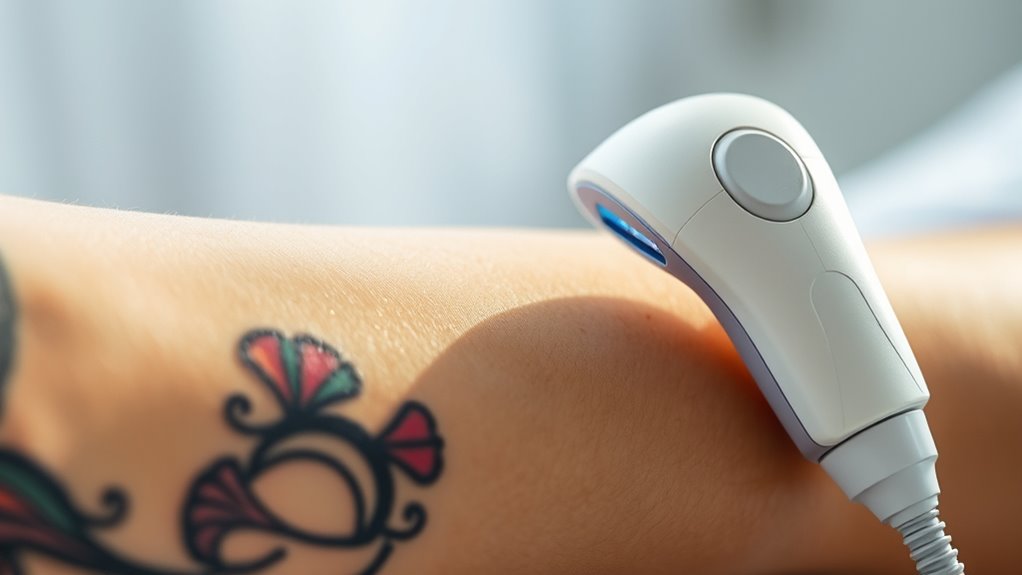
After IPL treatment, you should use gentle cleansing techniques to avoid irritating your skin. It’s also vital to stay out of the sun and protect your skin from UV damage. Keep your skin hydrated and moisturized to support healing and maintain your tattoo’s appearance.
Gentle Cleansing Techniques
Gentle cleansing is essential to protect your tattooed skin following IPL treatment, as harsh scrubbing or abrasive products can cause irritation or damage. To preserve tattoo ink durability and maintain healthy skin cleansing routines, follow these tips:
- Use a mild, fragrance-free cleanser with lukewarm water to avoid irritation.
- Gently pat your skin dry instead of rubbing, reducing stress on delicate skin.
- Avoid scrubbing or using abrasive tools that can disturb healed ink or cause scarring.
Stick to these routines to prevent damage, promote healing, and ensure your tattoo remains vibrant. Proper skin cleansing post-IPL helps protect both your skin and tattoo ink durability, supporting long-term tattoo quality while maintaining healthy skin.
Avoid Sun Exposure
Protecting your tattooed skin from sun exposure is an essential step in maintaining its appearance and health after IPL treatment. Sun protection minimizes the risk of pigmentation changes and skin sensitivity, which are common concerns post-procedure. To effectively shield your skin, use broad-spectrum sunscreen daily and wear protective clothing. Avoid direct sunlight during peak hours to prevent damage. Here’s a quick guide:
| Tip | Explanation |
|---|---|
| Apply sunscreen generously | Use at least SPF 30 on all exposed skin, especially tattoos. |
| Cover up with clothing | Long sleeves and wide-brim hats block UV rays. |
| Seek shade | Limit outdoor activities during midday hours. |
| Be consistent | Regular sun protection ensures long-term tattoo preservation. |
Prioritize sun protection to reduce skin sensitivity and keep your tattoos vibrant.
Hydrate and Moisturize
Keeping your skin well-hydrated and moisturized is essential for healing and maintaining the vibrancy of your tattoo after IPL treatment. Proper skin hydration helps repair damaged skin and preserves the clarity of your tattoo ink. To guarantee ideal care, follow these steps:
- Use a gentle, fragrance-free moisturizer to keep your skin barrier intact.
- Apply hydrating serums or ointments recommended by your dermatologist to support healing.
- Drink plenty of water daily to boost internal hydration and promote skin recovery.
Frequently Asked Questions
Can IPL Be Safely Used on Newly Tattooed Skin?
You shouldn’t use IPL on newly tattooed skin because it can interfere with the skin healing process. The intense light may cause irritation, affecting tattoo ink durability and potentially damaging the fresh ink. It’s best to wait until your tattoo fully heals, usually a few weeks, to guarantee your skin’s healed properly and the tattoo ink remains vibrant. Always consult a professional before any IPL treatment on tattooed areas.
How Does Tattoo Ink Color Affect IPL Treatment Outcomes?
You should know that tattoo ink color greatly influences IPL treatment outcomes. High contrast between skin and ink can lead to uneven results, affecting ink fading efficiency. Darker colors like black absorb more light, making treatments more effective and reducing the risk of adverse effects. Conversely, lighter or vibrant shades reflect more light, decreasing IPL’s effectiveness and possibly causing uneven fading or incomplete removal.
Are Certain Tattoo Styles More Prone to IPL Damage?
Certain tattoo designs with dense ink coverage or intricate details may be more prone to IPL damage. You should consider that high ink density absorbs more light, increasing the risk of burns or pigment disruption. Simple or lighter ink designs tend to be safer during IPL treatments. Always consult with a professional to evaluate your tattoo’s ink density and design, ensuring you minimize risks and achieve the best results.
What Are the Long-Term Effects of IPL on Tattooed Skin?
You might notice that IPL treatments cause some tattoo ink fading over time, which can alter your tattoo’s appearance. Additionally, IPL can affect your skin pigmentation, leading to uneven tones or discoloration. Long-term, these changes could be permanent, especially on heavily inked areas. It’s important to contemplate these risks before undergoing IPL on tattooed skin, as the effects can persist and impact your skin’s overall look.
Does the Location of a Tattoo Influence IPL Safety Risks?
Have you ever wondered if where your tattoo is located affects IPL safety risks? The answer is yes. Areas with different skin pigmentation or closer to sensitive regions pose higher risks during tattoo removal. Your skin’s pigmentation can influence how IPL interacts, potentially causing uneven fading or burns. So, consider the tattoo’s placement carefully, and always consult a professional to mitigate risks and ensure safe, effective results.
Conclusion
Guiding IPL treatments over tattooed skin is like walking a tightrope—one misstep can fade your ink or scar your skin. Before you leap, talk to pros and weigh your options carefully. Think of your skin as a canvas—you want it to glow without losing the masterpiece beneath. With the right guidance and caution, you can keep your skin vibrant and your tattoos intact, turning your skincare journey into a harmonious dance rather than a risky gamble.
